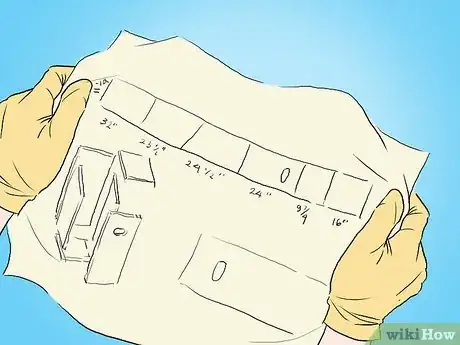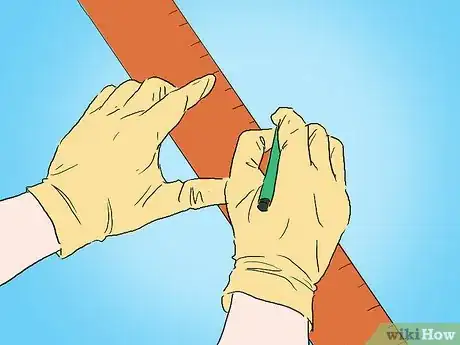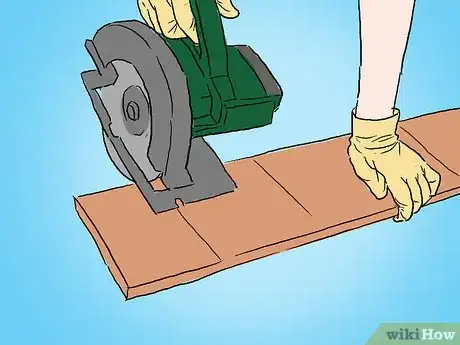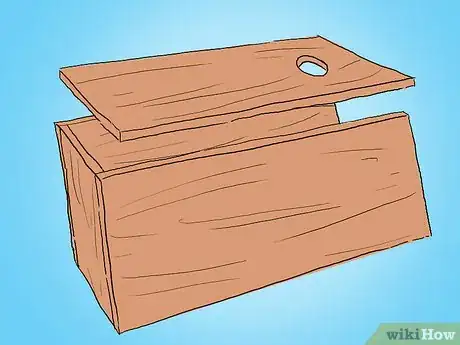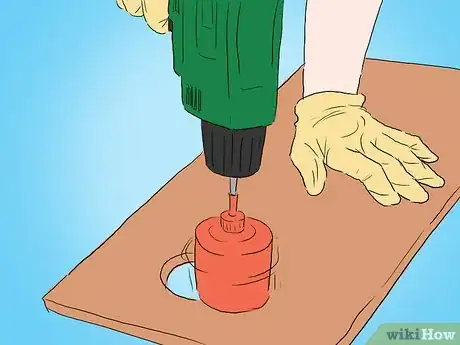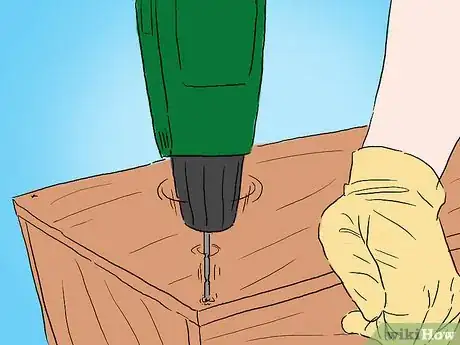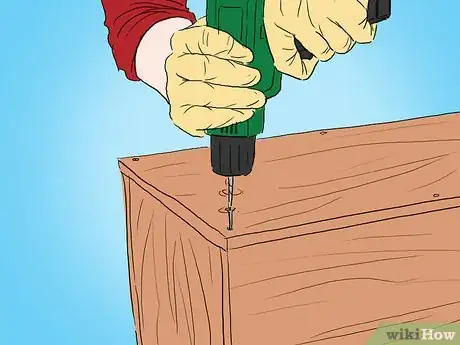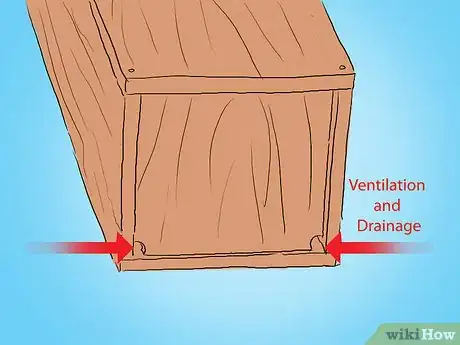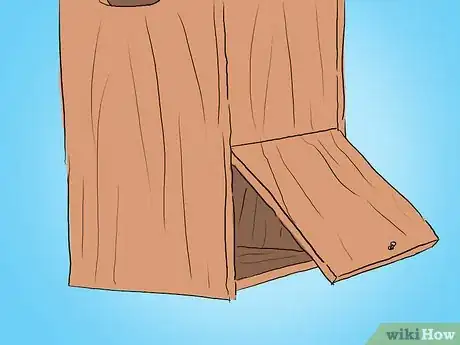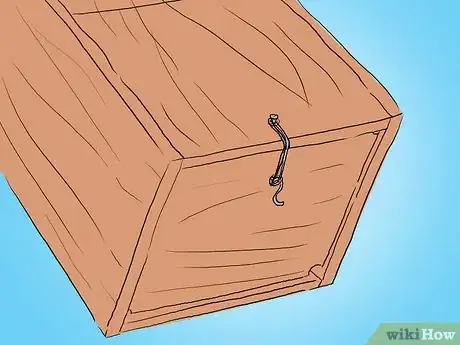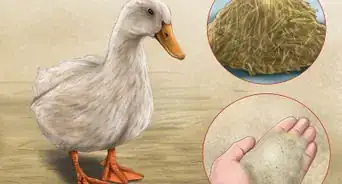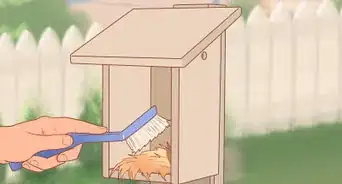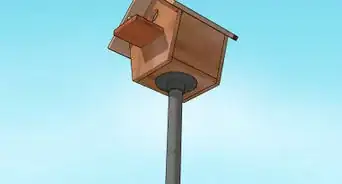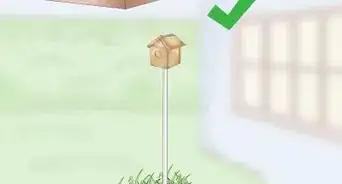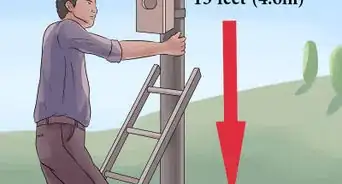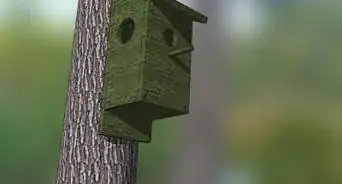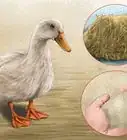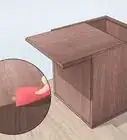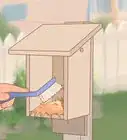wikiHow is a “wiki,” similar to Wikipedia, which means that many of our articles are co-written by multiple authors. To create this article, 24 people, some anonymous, worked to edit and improve it over time.
There are 10 references cited in this article, which can be found at the bottom of the page.
This article has been viewed 256,750 times.
Learn more...
The wood duck (Aix sponsa) is a colorful bird that usually nests in abandoned woodpecker holes, but will readily take to a nesting box of the correct dimensions, placed in the proper location.[1] Early in this century, wood duck populations were in decline; with a little time and effort, and some simple woodworking tools, you can help in the comeback of this fine bird by creating a wood duck nesting box for your local feathered friends.
Steps
-
1Review the plan, gather materials and tools. From one 11 1/4" (28.5 cm) wide by 12 foot (3.65 meters) long board you can make one nest box. The plan shown here explains how to divide the wood (click on the image to enlarge). It is best to use a weather resistant wood, such as cedar.[2]
-
2Lay out the design. Pencil draw the different pieces onto the wood. Keep in mind the importance of measuring twice, cutting once.Advertisement
-
3Cut materials to size.
NOTE: The back edge of the roof part should be cut with the saw adjusted to a 20 degree angle so that it fits flush with the back of the box.
NOTE: The front board in the layout is 1/2" (12.7 mm) too long. Cut off that 1/2" (12.7 mm) with the saw at a 20 degree angle (sloping away from the box) so the roof fits flush, and is therefore watertight.[3]- After cutting the wood, you should end up with the following pieces: a back, two sides, a front, a floor, and a roof.
-
4Dry fit the parts together to check the dimensions and angles. Do not use screws yet; it is important to fit the parts together to check the design and angles, before drilling and fastening. If anything requires adjusting, now is the time to do so.
-
5Create an entrance hole. It is easiest to drill the hole before assembling the box. A hole sized 3" (7.6 cm) high by 4" (10.2 cm) wide will admit ducks, but exclude raccoons. A hole of these dimensions can be created with a 3" (7.6 cm) hole saw by "staggering" two holes, as shown in the image. Locate the center of the hole 19" (48.3 cm) above the base of the front part.[4]
- The hole will be cleaner if drilled a little from both sides of the board.
- Use a rotary rasp or other tool to smooth out the oval opening.
-
6Create traction. The baby ducks will need a rough surface to grasp when attempting to leave the nest, and the momma duck will appreciate a rough surface on the front of the box when she lands. This can be accomplished by attaching screen or mesh, but suitable results may be obtained by setting the saw to make shallow Kerf cuts on both the interior and exterior of the front part.
-
7Start assembling. With the parts prepared, assembly can begin. Ring-shanked nails can be used, but exterior deck screws (2") (5 cm) create a more durable design that can withstand the elements for several years. To avoid splitting the wood, it is advisable to pre-drill the holes first.
-
8After the hole is drilled, insert a deck screw. It is handy to have two drills, one for the hole, and the other with a bit to drive the screws.
-
9Create drainage. Recess the bottom about 1/4" (6.35 mm) from the box base in order to provide a drip edge and to avoid rot. Drill holes in the base or cut about 1/4" (6.3 mm) off the corners for ventilation and drainage.
-
10Make an access point. One of the side parts should be cut to provide access for cleaning out old nesting material. Hinges can be used, but it is cheaper to simply use well placed nails (near the top of the opening board) as a pivot for the door.
NOTE: The board in this example was cut at a 20 degree angle to prevent rainwater leakage into the box (water doesn't like to run up-hill).[5] -
11Use sturdy wire to loop together two screws heads to secure the cleaning door. Raccoons can work a simple latch.
- A 1" X 11 1/4" (2.5 cm x 28.5 cm) strip can be used to hold the back of the lid in place and to further prevent rainwater leakage (see strip on lid in final image).
-
12Check that the wood duck nesting box is ready to place outside. When you're happy with it, place it in a suitable location to attract the local wood ducks. Ducks Unlimited advises that a wood duck nesting box is best placed on a wooden post or a metal pole designed with predator guards.[6]
- Boxes placed on posts in water should be about 5 feet (1.52 meters) above the water's surface.
- Boxes may be placed in woodlands areas up to one-half mile from water in trees or on a post at least 8 feet (2.4 meters) high, but preferably 20 feet (6.09 meters) high. To reduce the chances of predation, they should be 30 to 100 feet (9.14 meters to 30.48 meters) from the water's edge.
- Keep in mind to place the box:
- Near suitable brood habitat;
- Near shallow, fertile wetlands with thick cover; and
- Where there is a plentiful supply of invertebrates for eating.
- Don't forget to add a 4" (10.16 cm) layer of wood shavings for the nesting material. Suitable shavings include "chain saw" wood chips (or cedar wood chip bedding such as found in pet stores).
Community Q&A
-
QuestionWhat time of year do I place the box outside?
 Community AnswerYou may place it at any time.
Community AnswerYou may place it at any time. -
QuestionCan I paint it?
 Community AnswerYes, but if it's a food house, be careful. Use spray paint, and make sure it dries completely. Normal paint would chip and get into the seed; if they digest it, they could die.
Community AnswerYes, but if it's a food house, be careful. Use spray paint, and make sure it dries completely. Normal paint would chip and get into the seed; if they digest it, they could die. -
QuestionShould my wood duck house have a perch on the front entrance?
 Community AnswerI recommend it. I had a hen who just could not enter the house, she kept falling into the water. I tacked a piece of a paint stir stick under the hole and she grabbed that to enter. Problem solved.
Community AnswerI recommend it. I had a hen who just could not enter the house, she kept falling into the water. I tacked a piece of a paint stir stick under the hole and she grabbed that to enter. Problem solved.
Warnings
- Power tools can be dangerous, use more than common sense when using them.⧼thumbs_response⧽
Things You'll Need
- One 3/4" X 11 1/4" X 12' long (19 mm X 28.5 cm X 3.65 meters long) cedar board
- Tape measure, speed square, pencil
- A circular saw
- Two drills
- A small box of 2" (5 cm) exterior deck screws
- A 3" (7.6 cm) diameter hole saw
References
- ↑ http://www.ducks.org/hunting/waterfowl-id/wood-duck
- ↑ https://www.ducks.org/media/Conservation/GLARO/_documents/_library/_landowner/WoodDuck_NestBox.pdf
- ↑ https://www.audubon.org/news/how-build-wood-duck-nest-box
- ↑ http://www.ducks.org/media/Conservation/Conservation_Documents/_documents/duck_box_plans.pdf
- ↑ http://www.wlf.louisiana.gov/sites/default/files/pdf/publication/34730-wood-duck-nest-boxes-low-res/wood_duck_nest_boxes_low-res.pdf
- ↑ http://www.dnr.sc.gov/wildlife/waterfowl/woodduck/construction.html
- https://www.cumauriceriver.org/wp-content/uploads/2017/05/WOODDUCKBOX.pdf
- Woodworking for Wildlife, by Arkansas Game and Fish Commission - research source
- A Field Guide to the Birds East of the Rockies, by Roger Tory Peterson - research source
- Wikipedia on the wood duck - http://en.wikipedia.org/wiki/Wood_Duck
